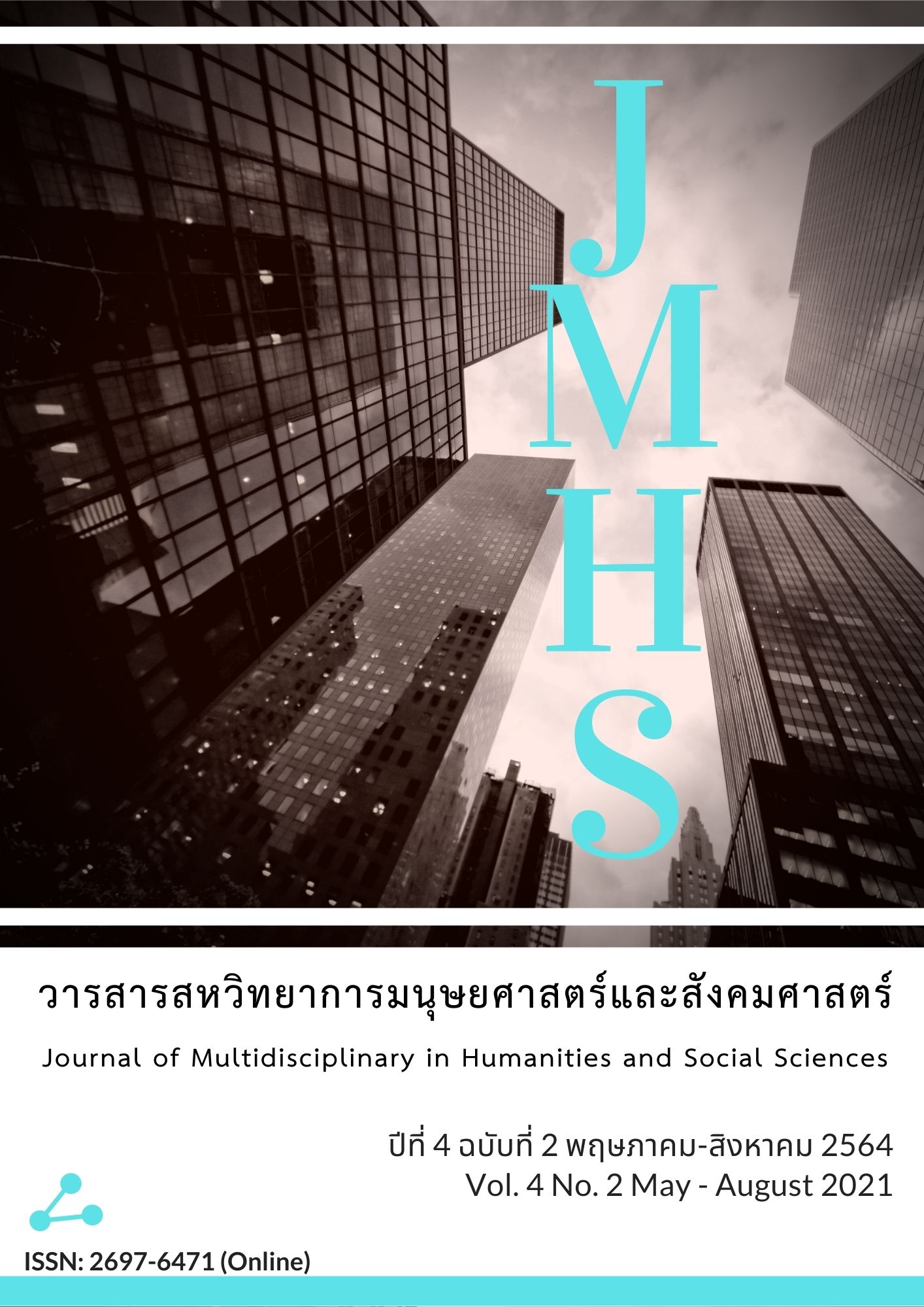A Study of Digital Survival Skills of Matthayom Sueksa Six Students
Main Article Content
Abstract
This research aimed to 1) study digital survival skills of Matthayom Sueksa Six Students; and 2) construct a cutting score for determining the test score in order to improve learning management. The sample consisted of 1,764 Matthayom Sueksa Six students from any schools under the Secondary Educational Service Area Office Six, Samutprakan province. The technique of multistage was used as sampling and the research instrument was a digital survival skills test.
The findings were as follows: Findings were found that digital survival skills of Matthayom Sueksa Six Students by determining the cutting score in 2 levels; the former is that the cutting score of the entire test score was at 80% and over and there were 10.32% of students who passed this level. The latter is that the cutting scores of each skill in the test were (1) 100% for networks and file management and there were 33.05% of students passed this level, (2) 95% and over for metacognition and life-long learning and there were 5.78% of students passed this level, (3) 90% and over for troubleshooting and there were 1.13 of students passed this level, (4) 85% and over for managing digital identity privacy and security and there were 3.23 of students passed this level, (5) 80% and over for strategic web and database searching and there were 12.64 of students passed this level, and (6) 100% for offences under the Computer Act and there were 45.46% passed this level.
Article Details
Views and opinions appearing in the Journal it is the responsibility of the author of the article, and does not constitute the view and responsibility of the editorial team.
References
กระทรวงศึกษาธิการ. (2549). การแบ่งขนาดโรงเรียนหรือสถานศึกษาตามเกณฑ์ของสำนักงานคณะกรรมการการศึกษาขั้นพื้นฐาน พ.ศ. 2549. สืบค้นเมื่อ 25 พฤษภาคม 2563, จาก http://www.secondary5.go.th/main/sites/default/files/ed information/71-80.pdf
คณะกรรมการการอุดมศึกษา. (2561). แนวทางการปฏิบัติตามกรอบมาตรฐานคุณวุฒิระดับอุดมศึกษาเกี่ยวกับสมรรถนะดิจิทัลสำหรับคุณวุฒิปริญญาตรี. ในรายงานการประชุม เรื่อง การนำสมรรถนะดิจิทัลมาเป็นแนวทางในการกำหนดมาตรฐานผลการเรียนรู้ ด้านที่ 5
ด้านทักษะการวิเคราะห์เชิงตัวเลข การสื่อสารและการใช้เทคโนโลยี (12 กันยายน 2561).
ฉัตรพงศ์ ชูแสงนิล. (2561). ยุคแห่งพลเมืองดิจิทัล. สืบค้นเมื่อ 5 พฤศจิกายน 2562, จาก https://www.scimath.org/article-technology/item/8659-2018-09-11-07-58-08
ฐิติยา เนตรวงษ์. (2561). ห้องเรียนดิจิทัลเพื่อการเรียนร่วมและพัฒนาทักษะการอยู่รอดในยุคดิจิทัล. วารสารพัฒนาเทคนิคศึกษา, 31(108), 15–28.
เด่นพงษ์ สุดภักดี. (2557). “การรู้ดิจิทัล”. ในรายงานการอบรม เรื่อง เทคโนโลยีสานสนเทศและการสื่อสารในการพัฒนาสื่อการเรียนรู้ดิจิทัลเพื่อการวิจัย (21 พฤศจิกายน 2557). กรุงเทพฯ. มหาวิทยาลัยเกษตรศาสตร์.
ธิดา แซ่ชั้น และ ทัศนีย์ หมอสอน. (2559). การรู้ดิจิทัล นิยาม องค์ประกอบและสถานการณ์ในปัจจุบัน. วารสารสารสนเทศ คณะมนุษยศาสตร์และสังคมศาสตร์, มหาวิทยาลัยราชภัฏนครศรีธรรมราช, 34(4), 116-145.
พนม คลี่ฉายา. (2559). การใช้งาน ความเสี่ยง การรู้เท่าทันสื่อดิจิทัล และแนวทางการสอนเพื่อการรู้เท่าทันสื่อดิจิทัล สำหรับนักเรียนมัธยมศึกษาในประเทศไทย. โครงการวิจัยระยะที่ 1-2, สำนักงานกองทุนสนับสนุนการวิจัย (สกว.).
พนม คลี่ฉายา. (2562). การใช้สื่อดิจิทัลและความเป็นพลเมืองของนักเรียนมัธยมศึกษาในประเทศไทย. คณะนิเทศศาสตร์, จุฬาลงกรณ์มหาวิทยาลัย.
มนัสวี แสงวิเชียรกิจ. (2557). เปิดประตูความดีสู่วิถีอาเซียน. กรุงเทพฯ: ศูนย์คุณธรรม.
แวววรรณ เตชาทวีวรรณ และ อัจศรา ประเสริฐสิน. (2559). การพัฒนาแบบวัดทักษะประการรู้ดิจิทัลของนักศึกษาระดับปริญญาตรี (วิจัยภาควิชาบรรณารักษศาสตร์และสารสนเทศ คณะมนุษยศาสตร์). มหาวิทยาลัยศรีนครินทร์วิโรฒ.
วัชราภรณ์ นัยกรณ์, จันทปภา บริบูรณ์ และ นาถลดา บุตรสันติ์ (2562). พฤติกรรมการใช้สื่อสังคมออนไลน์และการรู้สารสนเทศดิจิทัลของนักศึกษาที่มีความบกพร่องทางการได้ยิน ระดับชั้นปริญญาตรี มหาวิทยาลัยสวนดุสิต(วิทยานิพนธ์ศิลปศาสตรบัณฑิต). มหาวิทยาลัยสวนดุสิต.
วิโรจน์ สารรัตนะ. (2556). กระบวนทัศน์ใหม่ทางการศึกษา กรณีทัศนะต่อการศึกษาศตวรรษที่ 21. กรุงเทพฯ: ทิพยวิสุทธิ์.
วิทยา ดำรงเกียรติศักดิ์. (2558). พลเมืองดิจิทัล (Digital Citizenship). สืบค้นเมื่อ 7 พฤศจิกายน 2562, จาก http://www.infocommmju.com/icarticle/images/stories/icarticles/ajwittaya/digital/Digital_Citizenship.pdf
สุกัญญา แช่มช้อย.(2558). การบริหารสถานศึกษาในยุคดิจิทัล (School Management in Digital Era). กรุงเทพฯ: จุฬาลงกรณ์มหาวิทยาลัย.
สุวิมล ติรกานันท์. (2551). การสร้างเครื่องมือวัดตัวแปรในการวิจัยทางสังคมศาสตร์ แนวทางสู่การปฏิบัติ. (พิมพ์ครั้งที่ 2). กรุงเทพฯ: จุฬาลงกรณ์มหาวิทยาลัย.
เอกชัย กี่สุขพันธ์. (2559). การบริหารสถานศึกษายุคดิจิทัล (School Management in Digital Era). สืบค้นเมื่อ 20 มกราคม 2563, จาก http://www.trueplookpanya.com/knowledge/content/52232/-edu-t2s1-t2-t2s3-
AI Fern. (2020). Digital skill คืออะไร และมีความสำคัญอย่างไรใน Office ยุคใหม่. สืบค้นเมื่อ 5 มกราคม 2563, จาก https://www.asearcher.com/content/digital-skill--office.
Bawden, D. (2008). Origins and Concepts of Digital Literacy. In Digital Literacies: Concepts. Policies and Practices. Ed. by C. Lankshear & M. Knobe, 17–32.
Bryn Mawr College. (n.p.). Digital Survival Skills. Retrieved December 1, 2019, from https://www.brynmawr.edu/digitalcompetencies/digital-survival-skills
Frey, B. B. (2018). The SAGE Encyclopedia of Educational Research, Measurement, and Evaluation (Vols. 1-4). Thousand Oaks, CA: SAGE Publications, Inc.
Hague, C. & Payton, S. (2010). Digital Literacy Across the Curriculum. Bristol, UK.: Future lab.
JISC. (2010). Quick Guide-Developing Students’ Digital Literacy. Retrieved May 19, 2018, from https://digitalcapability.jiscinvolve.org/wp/files/2014/09/JISC_REPORT_Digital_Literacies_280714_PRINT.pdf/


